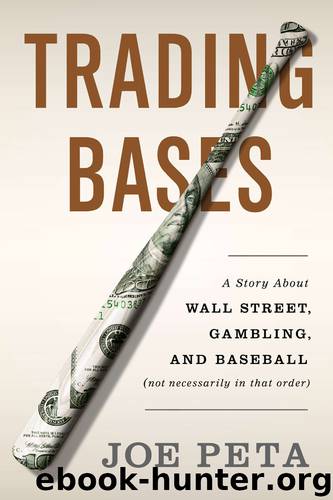Trading Bases: A Story About Wall Street, Gambling, and Baseball (Not Necessarily in That Order) by Joe Peta

Author:Joe Peta [Peta, Joe]
Language: eng
Format: epub
Publisher: Dutton
Published: 2013-03-06T16:00:00+00:00
15
June and the Vexing Minnesota Twins
Nearly half of the games played in June were interleague games. From June 17 through the end of the month, American League teams and National League teams played each other as they have since 1997. (Owing to the presence of two extra teams in the National League, there is always one traditional series between a couple of National League teams occurring at the same time.) In 2011, there was also a weekend of interleague games played in May and July. I knew interleague games would cause a problem for the model, because its backbone—projecting runs scored and runs allowed—was based on the 150 games or so each year that teams played under their own league’s rules, not the handful of games they played under the other league’s rules. (The American League, of course, uses a designated hitter in place of pitchers batting, as it has since 1973. For interleague play, games in American League parks use designated hitters, while games at National League venues do not.)
Additionally, comparing player values, in terms of WAR, for players from the American League and National League is not a perfect comparison, because the level of play in each league is different. For the past few years—and it only got magnified in 2012, with the defection of Albert Pujols and Prince Fielder to the American League—the average player in the American League has been better than the average player in the National League. I had known this and made adjustments I thought were appropriate, but I still dialed down the capital-allocation schedule for interleague games.
Even with the more conservative approach to capital allocation, the model lost money for the first month in June. The loss of 4.16 percent wasn’t just due to interleague play, however, as traditional league games accounted for 2.8 percent losses.
The Model’s Results in June
Total Return -4.16 percent
Year-to-Date Return +16.80 percent
Total Games Picked 339 (out of 400 played)
Record in Games Picked 178-161
Even with the half-month of interleague games, the model identified a perceived edge at the same rate as during the first two months of the season. There was nothing unusual about finding a preference on 85 percent of the games played, and the overall win percentage of 52.5 was actually better than the 51.6 percent the model posted through the end of May. A winning record with an overall capital loss suggested that there must have been some losses not only on favorites but on favorites that the model calculated had a big edge.
Return by Category of Team Selected
Win-Loss Record Return
Favorites 110-85 -4.17 percent
Underdogs 52-68 -0.12 percent
Pick-’Ems 16-8 +0.13 percent
Total 178-161 -4.16 percent
Return by Wager Size
Win-Loss Record Return
2 percent bets 2-2 +0.6 percent
1.5 percent bets 1-3 -4.24 percent
1 percent bets 8-6 -0.45 percent
50-basis-point bets 11-10 -2.32 percent
40-basis-point bets 26-26 +0.69 percent
20-basis-point bets 49-50 -0.20 percent
10-basis-point bets 81-64 +1.76 percent
The model did indeed take some lumps on its biggest plays. The overall loss would have been a lot worse without the solid showing on the small-size bets that made up the bulk of the total plays.
Download
This site does not store any files on its server. We only index and link to content provided by other sites. Please contact the content providers to delete copyright contents if any and email us, we'll remove relevant links or contents immediately.
The Infinite Retina by Robert Scoble Irena Cronin(6165)
Harry Potter and the Cursed Child: The Journey by Harry Potter Theatrical Productions(4440)
The Sports Rules Book by Human Kinetics(4292)
Molly's Game: From Hollywood's Elite to Wall Street's Billionaire Boys Club, My High-Stakes Adventure in the World of Underground Poker by Molly Bloom(3485)
A Knight of the Seven Kingdoms by George R R Martin(3191)
Quidditch Through the Ages by J.K. Rowling(3065)
How To by Randall Munroe(3034)
Flowers For Algernon by Daniel Keyes(3021)
Quidditch Through the Ages by J K Rowling & Kennilworthy Whisp(2930)
Quidditch Through the Ages by Kennilworthy Whisp by J.K. Rowling(2814)
Stacked Decks by The Rotenberg Collection(2811)
Quidditch through the Ages by J. K. Rowling(2768)
Quidditch Through The Ages by J. K. Rowling(2730)
776 Stupidest Things Ever Said by Ross Petras(2695)
Ready Player One: A Novel by Ernest Cline(2650)
What If?: Serious Scientific Answers to Absurd Hypothetical Questions by Randall Munroe(2637)
Beautiful Oblivion by Jamie McGuire(2569)
The Book of Questions: Revised and Updated by Gregory Stock Ph.d(2518)
Champions of Illusion by Susana Martinez-Conde & Stephen Macknik(2414)
